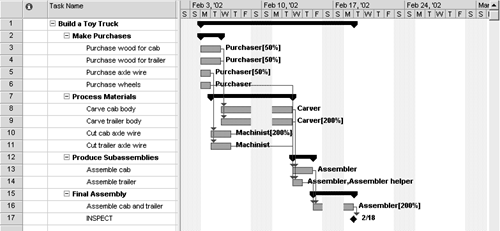| The Gantt chart concept goes back to the days of World War I. Yet, only since the 1980s have most new project management students become familiar with it. This late familiarity may be due to the recent and more widely accepted use of project management software and the use of the Gantt chart as a principal tool in software applications. Software applications are used to chart project tasks. Before the advent of software, the Gantt chart was done manually using graph paper. A project manager and project team have completed planning a project when they have determined what needs to be done when, in what sequence, by whom, over what period of time, and using what non-human resources. The project task list defines what needs to be done. When the task sequence and dependencies, and the required time estimated for each task has been determined, the outline can be converted to a flowchart that shows the project's timeline. If you identify who will execute each task, what effort each worker will devote to each task, along with what non-human resources are needed, you can establish the basis for defining the project's budget. When you have determined the time and effort buffers that must be added to the flowchart to allow for overrunning the original estimates and have determined where these buffers should be placed on the flowchart, you will have completed the work of project planning. We display the plan in the form of a Gantt chart. This small project Gantt chart is repeated here to aid the discussion of time, resources, and cost planning (see Fig. 6-2).
Figure 6-2. 
In Figure 6-2, the outline of the task list is displayed under the heading Task Name on the left-hand column of this chart. Bars laid out paralleling the calendar line and following each task name display each task's duration. The thin black lines ending in arrowheads indicate the task dependencies and sequences. The names beside the boxes indicate who will perform the task. If a worker will be busy full time executing the task, just his or her name or title is displayed. If he or she will only work part time, the percentage of time that he or she will work during the task effort is displayed in decimal form and in brackets, after his or her name. If two (or more) people in the same work category will work on the task, the number of those people in % (100% = 1) will be displayed inside the brackets (project task workers can be identified by their name or title). At this point in the project planning, non-human resources and time buffers are not displayed. They can be easily added. For each project, the knowledge required to fill in all of this information is distributed among the members of the project team. It is fundamental to IPM that the team members supply this information for the project plan. The problem that you may face is how to get from the point where the knowledge is scattered among team members to the point where you have a composite project Gantt chart. This situation is not unique to IPM. The method that we use in IPM is one where the team, under the project manager's leadership, cooperatively creates the Gantt chart. The Gantt chart not only displays the project plan, but it also will be the primary tool that a project manager uses to monitor, manage, and display progress when the project is being executed. These details are explained later in Chapter 12. |